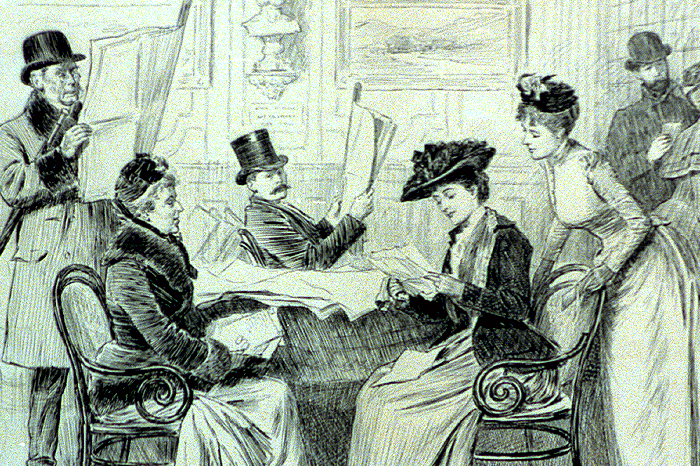By Ronny Litvack-Katzman, Research Assistant, ROAAr

Published in Harper’s Weekly, 3:200. March 15, 1890. Accessed Feb 25. 2022
Numbers, letters, and pseudonyms, reversed text, symbols, and foreign language words –the most infamous encrypted agony ads contained all these and more. Throughout the 19th century, ciphers and codes were a covert means for correspondents to communicate through the front pages of Victorian newspapers, drawing intrigue from the reading public. Serial consumers of the Agony Column were fascinated by the sometimes sordid stories, compelling readers to return to the ads day after day as their tales unfolded. Today, with the help of tools such as the Gale Digital Scholar Lab, we can access a digitized archive of The Times, the most popular newspaper of 19th-century Britain, and help uncover some of its secrets.
One of the most common ciphers in the agonies of The Times was a standard substitution cipher, also known as a monoalphabetic cipher. Substitution ciphers replace each letter of the alphabet with one ciphertext letter (for example, “a” becomes “c,” “b” becomes “d,” etc.), as in the example below from August 1853.[1] While the cipher may look daunting, connoisseurs of the agonies would have been able to crack the code in no time, usually by counting repeated letters and matching them to the most frequent in the English language: E, T, A, I, N, O, S.

Decryption: That the bent of every man’s mind should be followed in his education and on his destination in life is one fo the maxims which as been often repeated bu which cannot be admitted without many restrictions.
Other ciphers were considerably more complex. Running for five years between March 1850 and March 1855, the infamous “J. de. W.” series appeared in the Agony Column of The Times to suspicion and amusement. The elaborate code would have been almost impossible to break without a decryption key.[2] Even then, deciphering the message required an intimate knowledge of the code of signals for the merchant service.[3] Here, every lower-case letter corresponds to a number between 0 and 9, while the preceding upper-case letter refers to the section of the code where the corresponding word or phrase could be found.

Decryption to numeric:
No. ONE. – S. 6528. F. 428. C. 1046. 5714. F. 4068. 6370. 286.
S. 4608. F. 4576. B. 1062. F. 9735. C. 1742. Sh. 11. Capn. A.
F. 4068. 8720. C. 724. F. 286. 301. 7536. 9423. 9735. 9134.
8370. C. 34. F. 286. Eider. F. 9167. 4259. 1576. 286. S. 540.
F. 3829. 8954. E. 4362. F. 6031. 5193. 3698. C. 903. F. 8170.
S. 2015. – J. de W. Fri 1st Mar 1850
Decryption to plain text:
No. ONE. – All are [is?] well at Bolden[.] Jack has passed and
has just sailed in the Sphynx with Charles. Capn A.
has passed the Babin and another sailing vessel with two
steam boat[s,] Acorn and Eider[,] under his command and early in April
goes to Melville Island. No news [/] letters from Bernard [,] so
is expected to arrive.
Writing in 1881, editor Alice Clay wrote of the J. de. W. ciphers that they “strike forcibly” because they are “couched in an unintelligible style.” Ciphers like these were indomitable because matching their letters to a correct numeric sequence still would not have revealed a comprehensible message. Cracking the cipher required knowledge with which only a select few would have been familiar.
Other ads were enjoyed not for their secrecy but their enigma, along with the eye-catching and nonsensical messages they related. These agonies – such as the “Door mat” series that ran between 1849 and 1852 – while written in plain English, would have made little sense to anyone but the sender. Much like watching weekly episodes of a Netflix show, the multi-year timeframe over which the ads were placed enticed readers to pick up the Agony Column daily, lest they should miss the latest update.

While many encoded messages such as these remained a ‘public secret,’ not all correspondents were as fortunate. As public interest in the agonies grew, so did the number of people seeking to actively engage with cryptic messages. Part intellectual challenge and part entertainment, many readers attempted to demystify the otherwise indecipherable. And, to the chagrin of lovers, criminals, and pranksters alike, some succeeded. Check back next time to discover how the occasional Victorian would wake to find their secrets uncovered and displayed as front-page news!
[1] Code deciphered manually using the keys and appendices provided Jean Palmer’s The Agony Column Codes & Ciphers (57, 322-331). Cipher-text was first decrypted into the numeric code outlined by Palmer. Numeric code was deciphered into plain text by comparison with Captain Marryat’s A Code of Signals for The Merchant Service.
[2] Deciphered using Boxentriq’s online Cryptogram Solver and Cipher Identifier in addition to some manual analysis to correct inconsistencies in cipher key.
[3] https://archive.org/details/acodesignalsfor00marrgoog
Ciphers of the Times is a SSHRC-funded research project led by Nathalie Cooke, with assistance from Leehu Sigler, that investigates cryptic communication embedded in the Agony Columns of Victorian newspapers and their influence on Victorian society and literature. For updates, follow us on Instagram.












Leave a Reply
You must be logged in to post a comment.